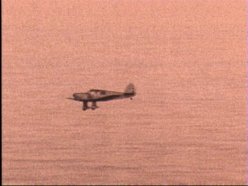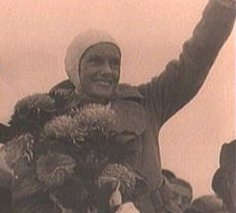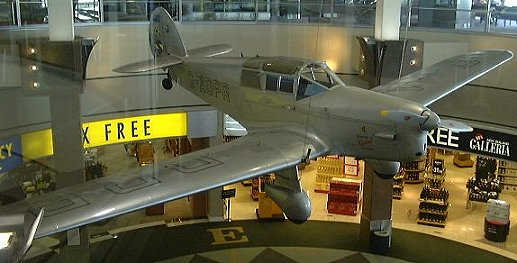![]()
Coasts
Rivers/Lakes
Lowlands/Plains
Geysers/Mud
Glaciers
Mt. Ruapehu
Mt. Cook
White Island
A Maori Legend
![]()
Abbotsford
Aramoana
Ballantynes
Brynderwyns
Cave Creek
Hawkes Bay
H.M.S. Orpheus
Influenza
Mt. Erebus
Mt. Tarawera
Rainbow Warrior
Seacliff Hospital
Tangiwai
Wahine
![]()
Annie Aves
Ata-hoe
Daisy Basham
Jean Batten
Minnie Dean
Mabel Howard
Margaret Mahy
Kath Mansfield
Kate Sheppard
Kiri Te Kanawa
Catherine Tizard
Murray Ball
Charles Goldie
Edmund Hillary
Richard Pearse
Lord Rutherford
Charles Upham
![]()
NZ FAQ--Funny
NZ Links
Credits
"Every flyer who ventures across oceans to distant lands is a potential explorer; in his or her breast burns the same fire that urged adventurers of old to set forth in their sailing ships for foreign lands." --Jean Batten, 'Alone In The Sky'. Jane Gardner Batten was possibly the most famous New Zealander of the 1930's. Known universally as 'Jean' this pioneer aviatrix broke many records and became known internationally. Born in Rotorua in 1909, Jean Batten made her first-ever flight with Sir Charles Kingsford Smith who was the first person to fly across the Tasman. Jean went up with him in his plane, The Southern Cross, in 1930. Later her mother took her to England with the intention that she should train in music and singing. Flying attracted this Kiwi girl more and -- with the 1930's being a time when aviators were breaking records all over the world -- Jean set about learning to fly. Her initial attempts at joining the birds were not that successful with landings being a serious problem and at least one crash into a fence being recorded. Jean was known to claim that she took to flying like a "penguin to water", however other pilots recall her as being a very slow learner and far from being a natural pilot. Even very early on she talked about flying from England to New Zealand -- though few watching her thought there was much chance of it. Nevertheless, eventually she became the first New Zealand female to secure the British Air Ministry's A licence. On the day of her first solo flight she shared the air with the R101 airship which crashed only days later.
Jean found it difficult to raise money to support her plans to fly to Australia, this was helped in 1933 when a fellow pilot agreed to share the costs of a second-hand Gypsy Moth aeroplane previously owned by the Prince of Wales. This allowed her to start for Australia that same year with two pieces of advice from Sir Charles Kingford Smith echoing in her ears, "Don't attempt to break men's records; and don't fly at night." She later said that she made a point of ignoring both of them. Her plans were stalled in India when a piece of machinery in her engine broke forcing Jean to crash-land. Though the pilot was not hurt the aircraft was badly damaged and she returned to England with assistance from the Castrol Oil Company who had sponsored many famous land and air records. Next she approached Shell insinuating that Castrol was about to fund her next flight, they agreed to supply fuel for her on credit. Back Jean went to Castrol convincing them to sponsor her to the tune of four hundred pounds, not enough to cover expenses, but a good start. Unfortunately, this next attempt also ended badly. On a dark, rainy night she ran out of petrol over Rome and had to glide to a landing in the city -- barely missing powerlines and masts in the process. The Moth was badly damaged on its wings, undercarriage and fuselage. The propeller was also damaged and the spare prop Jean carried also suffered the same fate when it broke loose. Two days after once again returning to London, in May 1934, Jean determinedly set off once again for Australia. Her route went from London to Rome to Cyprus, with the next intended stop to be Baghdad. However, she hit blinding sand storms and made a forced landing at an isolated desert outpost to wait it out. Onto Basra in the Persian Gulf, Jask in Iran, Karachi in Pakistan, Allabad and Calcutta in India, then Rangoon in Burma. It was here that disaster once more threatened to end her flight. The monsoon rains began and the deluge meant Jean could only see a few feet in front of the aircraft, then the open cockpit began to fill with water. Should she turn back to Rangoon? The answer came when Jean checked her fuel and discovered she wouldn't make it back. She continued to battle on through the pounding rain to land on a flooded airfield at Victoria Point. Early the next day she travelled onto Singapore, followed by Indonesia. Her lodgings overnight during her trip ranged from the houses of locals to large hotels. Car headlights were often used to assist in takeoffs, and on one occasion, a friend drove his car ahead of the plane to try to clear the fog.
The next stop was Australia and after fourteen and a half hours she landed in Darwin having broken the women's record for flying from England to Australia by four days. The total time taken on the trip was five days twenty-one hours. This was an amazing feat considering her little aeroplane had no radio or navigation equipment. Jean depended upon her compass and ability to accurately read maps to get her to her final destination. The uncovered cockpit meant she was exposed to burning sun, freezing winds and driving rain. Food consisted of a thermos of coffee and a packet of sandwiches. Jean travelled to New Zealand by sea with her plane where celebrations were held in her honour. She then travelled to Australia determined to make the return flight to England (April 1935). On her first day out she came as close to meeting death as anyone ever wants to. Her engine spluttered and died. Despite all attempts it refused to start again and slowly the plane began to glide towards the shark-infested waters below. Once the plane hit the water it would sink rapidly and Jean did not have a life jacket or raft. Preparing for the ditching Jean removed her shoes, undid her flying suit and grabbed the hatchett planning to attempt to hack off a wing for flotation. Four feet above the water the engine once more spluttered into life and its pilot, by this time in tears, was able to climb away from certain death. She continued with her journey but experienced further engine troubles and was delayed by foggy conditions over France. It took seventeen days and fifteen hours to complete the return flight. This was not a record but made Jean Batten the first women to make the return journey from Australia to England. Jean now sold her Gypsy Moth which was a slow aircraft and had a cruising speed of only 130 kilometres per hour. Instead she bought a Percival Gull monoplane, one of only nineteen ever made. With a cruising speed of 240 kilometres per hour it was nearly twice as fast and had a closed-in cockpit giving much-needed shelter from the weather. The Gypsy Moth was hand-started with a swing of the propeller whereas the Percival Gull had a convenient self-starter. On the 11th November, 1935 Jean set out from London to make an attempt on the record for flying from England to South America. The most demanding leg of this journey was the last one which involved a distance of almost 3,200 kilometres. One navigational error could be disastrous as the great distance meant Jean had no fuel to spare. After more than thirteen hours she touched down having achieved the fastest flight from England to South America by any man or woman, and the fastest Atlantic crossing up until that time. The next day there was excitement when Jean went missing on a routine flight to Rio de Janeiro. The Brazilian Air Force undertook an intensive search and located the Gull on a beach bogged down in sand and with a bent propeller. A tank fitting had loosened and she had run out of fuel; had this happened the prior day, during the flight over the ocean, pilot and plane would have disappeared without trace.
Just after Christmas Jean flew the Gull towards the Percival factory at Gravesend for the engine to be overhauled. She crashed in conditions of low cloud yet told a newspaper reporter the accident was due to engine failure. There has been some suggestion this was to avoid admitting to a mistake which would reflect badly on her abilities as a pilot. By this stage the Prime Minister of New Zealand, Michael Savage, wanted Jean to be made a Dame of the British Empire (the equivalent of a knighthood). Instead, she was awarded a CBE, New Zealand as a country had very little say in who should receive Queen's honours at this time. It was October 1936 and one record remained for Jean to gain. She still wanted to make that flight from Australia to New Zealand which had been discussed when she was just learning to fly. This meant a journey of more than 22,500 kilometres but the Gull was a much faster aircraft, less stops were needed for refueling, and she completed the trip to Australia in only five days and twenty-one hours. Due to storms over the Tasman Sea jean delayed the final leg of her flight to New Zealand by two days. During this time many people actively attempted to discourage the headstrong young girl from making the attempt. Jean Batten had to calculate this trip very carefully. She would lose two hours of daylight because she was travelling in the opposite direction to the sun, and if she miscalculated in her navigation, without a radio or life raft, she faced death. Finally land came into view and she was over New Plymouth airport. Without landing she turned the Gull towards Auckland where her father and a vast crowd waited in welcome. The solo flight from England to New Zealand had taken eleven days and forty minutes, this record was to be held by Jean Batten for more than forty years.
Upon her return to Australia she joined the search for a missing aeroplane. The Stinson had been carrying seven passengers, one of which was Jean's fiance. When found he was dead, along with five of the other passengers; the heart-broken Jean decided to occupy her mind by flying back to England. On the October 1937 journey she did a lot of night flying which reduced her travel time, yet took a great toll on her. At Naples she had to be lifted from the cockpit of the Gull, being too exhausted to get out. At Lympne she had to be carried into customs. Jean eventually reached London after only five days and eighteen hours, yet another record. A crowd of more than ten thousand people waited to greet her and policemen were forced to carry her through the crowd on their shoulders. She was invited to Buckingham Palace, then served as a nurse in the war. She had to stand and watch as the RAF pressed her Gull into action, the first time anybody other than herself had been at the controls. During this time she once again fell in love and planned to marry. Her second fiance was a bomber pilot; sadly he was killed in action. After the war ended Jean and her mother lived in Europe. After her mother's death Jean became almost a recluse though she returned to New Zealand several times, once being in 1976 to celebrate the fortieth anniversary of her flight to New Zealand. Plans were also made to fly Concorde over her original route from England to Australia but the project was cancelled. In 1979 Jean's beloved and long-held solo England to Australia light aircraft record was finally broken, well and truly ending a Golden Age of aviation. Judith Chisholm flew a turbo-charged single-engine Cessna Centurion. She had the assistance of the most modern radio and navigation equipment, cruised mostly above 20,000 feet and set a time of 3 days 11 hours. She then flew the leg to Auckland where Jean Batten herself greeted the new record holder. In October 1982 she moved to the island of Majorca and soon afterwards was bitten by a dog. The bite turned septic and she died alone in her room on 22nd November. It's difficult to believe someone who was once so popular could be totally unrecognised after her death, yet this is what happened. In Spain people are normally buried under their middle names and so she was buried under G for Gardner. She was buried in a paupers grave, not until 1987 did her family manage to trace what had happened to her. There were 150 bodies packed into the communal grave and finding her remains amongst the others would have been impossible; a simple plaque was erected on the wall above the grave. Meanwhile, the Percival Gull had survived its work for the RAF and from there G-ADPR had gone into the possession of the Percival Aircraft Company. They then passed it into the hands of the Shuttleworth Trust at Old Warden Aerodrome in Bedforshire, England who restored it to full flying trim. Some years later Shuttleworth decided to sell some of its collection and the Gull was purchased by Auckland International Airport Ltd (AIAL). It is now permanently on display in the international terminal.
|


 After this she returned to New Zealand where her licence
was later endorsed allowing her to carry passengers. Back in Britain
she obtained a B licence permitting her to fly commercially and
this led her to set up a passenger air service. Her training for
this included learning navigation, studying weather and engine maintenance,
all things which would prove invaluable during her solo flights.
After this she returned to New Zealand where her licence
was later endorsed allowing her to carry passengers. Back in Britain
she obtained a B licence permitting her to fly commercially and
this led her to set up a passenger air service. Her training for
this included learning navigation, studying weather and engine maintenance,
all things which would prove invaluable during her solo flights.



